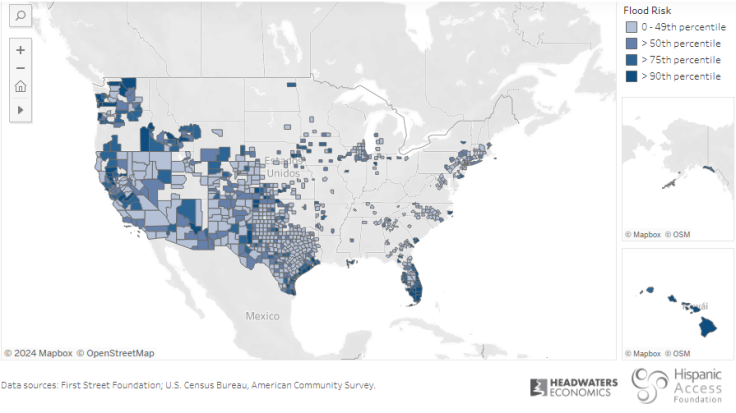Latinos in the U.S. face a disproportionately higher risk of flood compared to other demographics, its impact widening existing inequities. This conclusion was reached by the Hispanic Access Foundation and Headwaters Economics in a new study, which analyzes the group's vulnerabilities and proposes a series of resilience strategies to mitigate them.
The report highlights that 25% of Latinos in the U.S. live in a county that has experienced a a federal disaster declaration for flooding in 2023, compared to 10% of non-Latinos who have been through this situation. At a national level, 44% of Latinos live in counties with high flood risks, in contrast with 35% of non-Latinos.
Language barriers, inadequate housing, or local governments that lack the capacity to fully implement solutions are some factors that compound to these vulnerabilities.
Latinos often struggle to access federal disaster aid after a disaster and are more likely to lose wealth in the long term when compared to White, non-Latino households, the document adds, providing figures to back the statement: "In counties that suffered more than $10 billion in disaster-related damages from 1999 to 2013, Latino households lost an estimated $29,000 in wealth—higher losses than other demographic groups."
The report included a map illustrating where Latinos face higher risks of flooding. Most counties with higher risk are in southeast Texas, southern Florida and the northeastern coast. Practically all of California, Nevada, Arizona and New Mexico are included as well, but with lower levels of risk.

"Counties with high flood risk and large shares of Latino people range from hurricane-prone counties – such as Miami-Dade County, Florida, and Cameron County, Texas – to counties with large agriculture sectors, such as Sonoma County, California, and Chelan County, Washington. Other areas with large shares of Latino people and high flood risk may be more unexpected, such as urbanized Cook County, Illinois (where Chicago is the county seat) and tourism-dependent Teton County, Wyoming, home of Jackson Hole Mountain Resort, "specifies the document.
Other figures showing disproportionate vulnerabilities are:
- 35% of Latinos live in counties with high flood risks and many non-English speakers vs- 13% of non-Latinos
- 32% of Latinos live in counties with high flood risk and high poverty rates vs. 18% of non-Latinos
- 31% of Latinos live in counties with high flood risk and many uninsured people vs. 18% of non-Latinos
- 32% of Latinos live in counties with high flood risk and unaffordable housing vs. 18% of non-Latinos
- 17% of Latinos live in counties with high flood risk and evacuation challenges vs. 10% of non-Latinos
With those stats in mind, the document proposes a series of measures across the country. The first one is addressing cultural barriers to accessing resources: "More deliberate planning and outreach can help. For example, after a disaster preparedness training series was conducted by the American Red Cross and Hispanic Access Foundation, the Red Cross saw a threefold increase in downloads of their Spanish-language emergency application," reads a passage of the study.
The organizations also propose disaster policies are used to address the root causes of vulnerabilities, saying that many communities with high exposure to flooding have a "history of disinvestment that has exacerbated their risks."
"Local, state, and federal agencies should prioritize strengthening overall community wellbeing and creating economic opportunity. Housing is one critical element. Government agencies can address the root causes of vulnerabilities by investing in creating and preserving durable, affordable housing," the report says.
The third and last proposal is investing in risk-reduction strategies in places with high exposure and vulnerability. "State and federal government agencies can help lower-capacity communities by providing them with technical assistance, helping to coordinate regional or watershed collaboratives, and providing long-term, predictable revenue for resilience investments," the document concludes.



